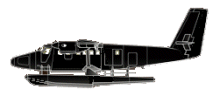Incident Overview

Description
A Maldivian Air Taxi float-equipped DHC-6 Twin Otter was substantially damaged when it suffered an accident while landing on the Halavelhi Resort lagoon. The 8Q-MAG aircraft departed at 09:45, with 3 crew and 4 passengers on board, for a photo flight around the Lagoon of Halaveli (North Ari Atoll) from the floating platform (fixed to jetty) of Halaveli (North Ari Atoll). The sky was clear with good visibility and wind, 8-10 knots, from westerly direction. The estimated flight time for the flight was 40 minutes. The aircraft took off westbound. After levelling the aircraft the co-pilot gave his seat to the cameraman, one of the passengers. The co-pilot remained at third row left seat from thereon until the aircraft met the accident. According to the crew and passengers the aircraft made few orbits (right bank) around the island at the initial levelled height and, then descended lower heights and made few more orbits around the lagoon for photography. The passenger seated at the cabin wearing the headset informed the PIC that they got all the shots they wanted and now he could land. PIC started a descending turn (right bank) while keeping the passenger at the co-pilot seat in order to give a different view to him. Before the PIC could complete the turn, the right wing and/or float hit the water. The accident resulted in both wings being broken at the root. Left float was detached and right float got stuck, between the engine and the fuselage, blocking the co-pilot exit. Empennage was twisted upside down. The depth of the lagoon at the site of wreckage was about 1 metre. All the passengers and crew were able to escape the aircraft without any fatalities. CAUSAL FACTORS: – The PICs decision to fly the aircraft, other than for take-off and landing, lower than an altitude allowed by CAD regulations and Company Operations Manual. – A passenger occupying the co-pilot seat. – No effective means established by the operator to ensure that amendments to the regulations, guidance, procedures are communicated to the crew appropriately and in a timely manner.
Primary Cause
Failure to adhere to regulatory constraints and operational procedures, specifically the PIC’s decision to deviate from established altitude limits and company operational guidelines. The presence of a passenger occupying the co-pilot seat, coupled with a lack of timely communication regarding amendments to regulations, significantly contributed to the accident.Failure to adhere to regulatory constraints and operational procedures, specifically the PIC’s decision to deviate from established altitude limits and company operational guidelines. The presence of a passenger occupying the co-pilot seat, coupled with a lack of timely communication regarding amendments to regulations, significantly contributed to the accident.Share on:

